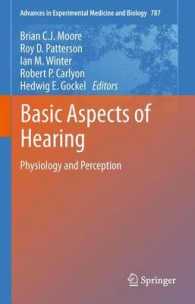Full Description
U.S. students exit undergraduate science, technology, engineering, and mathematics programs at alarming rates. Less than 50 percent of the undergraduate students who enter STEM degree programs as aspiring freshmen complete degrees in these areas. This is especially true for minorities, whose departure from STEM degree programs is often twice the rate of others.Broadening Participation in STEM features chapters from developers of high impact educational practices and programs that have been effective at broadening the participation of underrepresented groups in the STEM disciplines. It explores strategies used with special populations of STEM aspirants including minority groups such as African Americans, Latino Americans, and Native Americans; persons from economically disadvantaged background; and persons with disabilities. This volume contributes to national knowledge of best practices in educating underrepresented students aspiring to STEM careers.
This book provides campus-based faculty, administrators, and diversity professionals with a guide that can be used to develop programs designed to address specific student success and inclusion goals in STEM programs.
Contents
PART IChapter 1. LSU Office of Strategic Initiatives: A Great Equalizer for Broadening Participation in STEM; Tyrslai M. Williams, Melissa B. Crawford, Linda M. Hooper-Bui, Stephanie Givens, Heather Lavender, Shannon Watt, Isiah M. Warner
Chapter 2. Empowering Undergraduate Students to Lead Research: The ASCEND Program at Morgan State University; Farin Kamangar, Gillian Silver, Christine Hohmann, Shiva Mehravaran, Payam Sheikhattari
Chapter 3. Advancing STEM by Transforming Pedagogy and Institutional Teaching and Learning: The Creation of a STEM Center of Excellence for Active Learning; Margaret I. Kanipes, Guoqing Tang, Faye Maor, Zakiya Wilson-Kennedy, and Goldie S. Byrd
Chapter 4. Transforming STEM Departments for Inclusion: Creative Innovation, Challenges, Adaptation, and Sustainability at University of Arkansas Fort Smith; Sayo Fakayode, Jennifer Jennings Davis, Linus Yu, Paulette Ann Meikle, Ron Darbeau, Georgia Hale
Chapter 5. NanoHU: A successful collaborative STEM model preparing African Americans for engagement in nanoscience, laying the foundation for transformative, institutional STEAM engagement; Michelle O. Fletcher Claville, Sainath Babu, Brandon C. Parker, Emorcia V. Hill, Eric W. Claville, Michelle Penn-Marshall
Chapter 6. All For One And One For All: Coordinating the Resources of Individual Student Research Training Initiatives In Biomedical Sciences at Xavier University of Louisiana; Maryam Foroozesh, Marguerite Giguette, Teresa Birdwhistell, Kathleen Morgan, Kelly Johanson, Tiera Coston, Clair Wilkins-Green
Xavier
PART II
Chapter 7. Cultivating Agency through The Chemistry And Biochemistry Curriculum At Spelman College; Leyte L. Winfield, Lisa B. Hibbard, Kimberly M. Jackson, Shanina Sanders Johnson
Chapter 8. High-Impact Educational Practices that Promote Student Achievement in STEM; Angela W. Peters, Verlie A. Tisdale, Derrick Swinton
Chapter 9. Supplemental Instruction Levels the Playing Field in STEM at Louisiana State University; Gloria Thomas, Lahna Roche, Melissa Brocato, Saundra Y. McGuire
Chapter 10. History and Evolution of STEM Supplemental Instruction at San Francisco State University, a Large, Urban, Minority-Serving Institution; A. Alegra Eroy-Reveles, Eric Hsu, Kenneth A. Rath, Alan R. Peterfreund, Frank Bayliss
Chapter 11. Math Emporium Instructional Course Design: Algebra Course Evolution at an HBCU; Kathy Cousins-Cooper, Dominic P Clemence, Thomas C. Redd, Nicholas S. Luke, Seung-Tae Kim
Chapter 12. Process-Oriented Guided Inquiry Learning (POGIL) at Jackson State University and Tuskegee University; Naomi Campbell, Melissa S. Reeves, Marilyn Tourne', and M. Francis Bridges
Chapter 13. A Cultural Shift: A Transformative Approach to Advising STEM Students at an HBCU; Mary A. Smith, Angela M. White, Kelsie M. Bernot, Cailisha L. Petty, C. Dinitra White, Grace E. Byfield, Robert H. Newman, Roy J. Coomans, Checo J. Rorie
Chapter 14. Transitioning From a Traditional Lecture Style Organic Classroom to a "Flipped" Classroom; Angela Winstead, Liuli Huang








